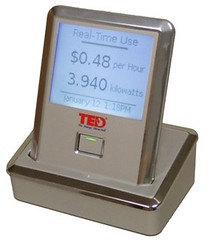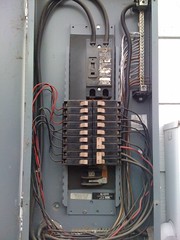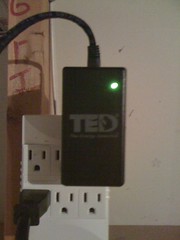 I've always been curious about the Kill-a-Watt device works but never could rationalize getting one since it's so limited. In a nutshell, it is a device (or powerstrip) you plug into the power outlet then plug in one or more electronics to it and it will read out your power usage. I read some models will calculate your cost of the power as well. Looking into gadgets for the new home I came across what I call a “whole house Kill-a-Watt” - The Energy Detective (or TED).
I've always been curious about the Kill-a-Watt device works but never could rationalize getting one since it's so limited. In a nutshell, it is a device (or powerstrip) you plug into the power outlet then plug in one or more electronics to it and it will read out your power usage. I read some models will calculate your cost of the power as well. Looking into gadgets for the new home I came across what I call a “whole house Kill-a-Watt” - The Energy Detective (or TED). TED, made by Energy Inc, http://www.theenergydetective.com/index.html has had their first generation product out for a while it looks like. I read that the next generation – the 5000 series – just came out this summer in 2009. I figured this was a perfect opportunity to get in on it as well as starting to monitor our power usage from almost day 1 in the house. I found they did not have the 5000 series listed for sale online but according to a few blogs you could call them up and make an order. I sent an email to find out more and their very helpful support let me know the main reason for not being for sale online was they only have a few still in stock and are totally out of the remote display device. I went ahead and made an order for the TED 5000-C which included everything I need for one electrical panel, the webserver that they call their gateway and a display that they will ship later. $256 shipped
TED, made by Energy Inc, http://www.theenergydetective.com/index.html has had their first generation product out for a while it looks like. I read that the next generation – the 5000 series – just came out this summer in 2009. I figured this was a perfect opportunity to get in on it as well as starting to monitor our power usage from almost day 1 in the house. I found they did not have the 5000 series listed for sale online but according to a few blogs you could call them up and make an order. I sent an email to find out more and their very helpful support let me know the main reason for not being for sale online was they only have a few still in stock and are totally out of the remote display device. I went ahead and made an order for the TED 5000-C which included everything I need for one electrical panel, the webserver that they call their gateway and a display that they will ship later. $256 shipped
The box showed up pretty quick and I was excited to get it installed that night. Everything looked to be included with nothing missing, great experience so far. I was pretty familiar with the electrical system of the house since the inspector I hired took the time to explain every bit of the house to me in detail. I knew all the breakers were being used but there was room for more. A quick jaunt to the hardware store (literally a minute from the house) to pick up a breaker and I was in business.
The MTU consists of two clamps that attach to the incoming power feed, that connects to a small box placed inside the box. Three wires come out of the box, 1 for the A phase, 1 for the B phase and another to attach to the ground bar. The only trouble I had installing was a slight fear of killing myself in one of the very first projects of the house, and that I ran out of sunlight. The wife and dogs weren't too happy about having the power shutoff while I got it installed. All said and done no death and still married! I do still need to clean up the box by attaching the MTU with doublesided tape to the side, right now it's just sitting on the bottom. Thanks to the wonders of battery backup, I noticed my computers and internet connection stayed up. Microwave clock flashing 12:00 was not as lucky.
“Well that was easy” I thought, “I'll surely have issues installing the gateway, I mean a company focused on a utility can't have that much experience with a computer device.” I went ahead and plugged in the gateway which consists of a wall wort sort of box, and an RJ45 port for a network cable. LED's started flashing as I read it should, excellent. I got onto a web brower and tried to hit up the web interface on the URL provided in the documentation, but all my systems are configured for my own search domain. This meaning it would try to autocomplete http://TED5000/ to TED5000.mydomain.blah.com or just TED5000.com. I pulled up my routers web interface and was able to track down the IP that TED got from DHCP and was then able to pull up the webpage. Granted this was mostly an environmental issue in my own network, it would be nice if they had a default static address – it's a trade off either way I suppose. Doing it this way is probably easier for the majority of users.
focused on a utility can't have that much experience with a computer device.” I went ahead and plugged in the gateway which consists of a wall wort sort of box, and an RJ45 port for a network cable. LED's started flashing as I read it should, excellent. I got onto a web brower and tried to hit up the web interface on the URL provided in the documentation, but all my systems are configured for my own search domain. This meaning it would try to autocomplete http://TED5000/ to TED5000.mydomain.blah.com or just TED5000.com. I pulled up my routers web interface and was able to track down the IP that TED got from DHCP and was then able to pull up the webpage. Granted this was mostly an environmental issue in my own network, it would be nice if they had a default static address – it's a trade off either way I suppose. Doing it this way is probably easier for the majority of users.
 My first experience in the web interface was simply – WOW, this is well done. After walking through some simple setup wizards the gateway was picking up the signal just perfectly from the electrical panel. “It just can't be this easy” I thought. A day or two later I finally did hit a stumbling block, I started getting bad readings in the history, both huge numbers and negative. Even updating the firmware from the newest on their website was not fixing it. An email to support produced a quick email from one of their engineers, and a beta firmware update for both the MTU and Gateway. Now that's what I call service from what surely is a small company and not a very expensive device! After running for 12 hours on the new firmware it looks great. I could be wrong, but the interface seems to work a lot better, snappier between pages and the data seems to be more consistent and accurate.
My first experience in the web interface was simply – WOW, this is well done. After walking through some simple setup wizards the gateway was picking up the signal just perfectly from the electrical panel. “It just can't be this easy” I thought. A day or two later I finally did hit a stumbling block, I started getting bad readings in the history, both huge numbers and negative. Even updating the firmware from the newest on their website was not fixing it. An email to support produced a quick email from one of their engineers, and a beta firmware update for both the MTU and Gateway. Now that's what I call service from what surely is a small company and not a very expensive device! After running for 12 hours on the new firmware it looks great. I could be wrong, but the interface seems to work a lot better, snappier between pages and the data seems to be more consistent and accurate.
I also came across an unofficial iPhone app that simply connects to the API of TED's gateway and shows all the current information. Not having the display yet, this is pretty handy to walk over to some lights, check the usage, turn them off and re-check. I am slightly disturbed that the 20 year old clothes washer that came with the house uses so much dang electricity! Newer ones have GOT to be more efficient.
In summary, it seems totally worth the cost as just being mindful of usage day to day, and parts of the day will go a long way to efficiently turning things off when not using or tracking down something I left on. Time will tell though, I'll be sure to track my progress here.

After not getting any support from the company, I decided to start my own support group…
ReplyDeleteFor those interested…. Join here
http://tech.groups.yahoo.com/group/TheEnergyDetective/